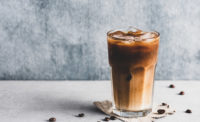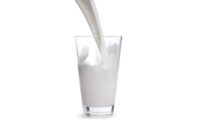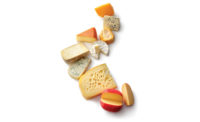On the nondairy beverage front, the ready-to-drink (RTD) coffee and tea category has been throwing some well-placed hooks and jabs. Sales in the total category, including refrigerated and shelf-stable offerings, rose 11.5% during the 52 weeks ending Aug. 12, 2018, to $1.8 billion, according to data from Chicago-based market research firm IRI.
RTD coffee goes the distance
Sales in the refrigerated RTD coffee subcategory skyrocketed 20.1% during the 52 weeks ending Aug. 12, 2018, to reach $341.7 million. On the shelf-stable side, RTD cappuccino/iced coffee sales reached $2.6 billion, reflecting a 10.6% increase, IRI data show.
Milk | Cheese | Cultured | Ice Cream | Butter | Non-dairy Beverages | Ingredients | Exports
“After years of weak performance, ready-to-drink coffee has caught fire in the U.S.,” said Gary Hemphill, managing director of research at Beverage Marketing Corp. (BMC), New York.
The shift away from carbonated soft drinks is partially to thank for boosting the performance of RTD coffee, Matthew Barry, senior beverages analyst for London-based Euromonitor International, noted.
“The decline of carbonated soft drinks and other high-sugar products has created a real opportunity for emergent soft drink categories,” he explained. “RTD coffee has done a good job in moving into some of these occasions. … The rate of new product launches is just incredible.”
One such new product is from Chicago-based McDonald’s Corp. The company released its McCafé coffee drinks at retail stores this year. Produced, distributed and marketed by Atlanta-based The Coca-Cola Co., the new McCafé Frappé line includes caramel, mocha and vanilla flavors.
Additionally, Emeryville, Calif.-based Peet’s Coffee recently launched Peet’s True Iced Espresso in black and white, caramel macchiato, vanilla latte and mocha flavors. The premium, single-origin RTD coffee line was inspired by the top-selling drinks in Peet’s coffee bars, the company said.
Much of the success of the RTD coffee also can be attributed to the popularity of cold-brew coffee.
“[Cold-brew coffees] have enabled entrepreneurs to enter the hard-to-crack RTD coffee space, as well as give established players a platform with which to diversify,” said Roger Dilworth, senior editor with BMC. “It could be argued that RTD coffee would have decelerating growth by now if not for the emergence of the cold-brew sub-segment.”
Within this space, Glendale, Calif.-based Nestlé USA acquired Chameleon Cold-Brew, Austin, Texas, late last year. Chameleon Cold-Brew was the top-selling cold-brew coffee in the 52 weeks ending July 15, 2018, in multi-outlets, according to IRI data.
And Seattle-based Starbucks Corp. recently expanded its investment in the segment by adding two flavors to its existing cold-brew coffee line: vanilla & fig and sweetened black. The company also expanded its original flavor — black unsweetened cold brew — into a larger 32-ounce multi-serve bottle.
RTD tea gives it the ole’ one-two
Sales in the refrigerated RTD tea subcategory jumped 9.7% to $1.5 billion. The larger shelf-stable canned and bottled tea segment, meanwhile, saw more modest growth, with sales growing 1.4% to $3.6 billion.
“Reformulation and ingredient clarity has been a major driver as to why RTD has rebounded so strongly,” said Kevin Weissheier, consumer insights executive with New York-based Kantar Worldpanel U.S. “Consumers see health and hydration values with RTD, which nicely complements the taste.”
Hemphill noted that the RTD segment is the only tea segment experiencing growth.
“On a dollar basis, performance was better in 2017, with total retail dollars up nearly 2%,” he said. “Consumers want convenience, which has made RTD tea a big winner. Most of the other segments have experienced lackluster performance.”
Competition between tea and coffee is fierce. But products featuring blends of tea and coffee could be the next evolution for the beverage industry, Weissheier said.
Macro health-and-wellness trends are impacting the popularity of functional teas.
“As is common, consumers are expecting their beverages to do more than deliver on just taste. They want benefits such as health, hydration and functional factors,” Weissheier said.
Consumers also prefer flavor variety and more complex profiles, he added.
At Natural Products Expo West in March, Los Angeles-based Zevia showcased a line of new organic RTD teas in eight flavors, including black tea, green tea and herbal flavors. Featuring two caffeine-free options, the line launched nationwide in 12-ounce slim cans in late summer. The non-carbonated shelf-stable teas have zero calories and are naturally sweetened with stevia, the company said.
And Sparks, Nev.-based Davidson’s Organics recently launched a line of seven Ayurvedic-inspired functional teas that are designed to aid with sleep, slimming, energy and decongestion, the company said.
Like many other beverage categories, natural and organic trends are influencing the tea category. Twenty-two percent of consumers look for new food/beverage products that are made from natural ingredients, and 38% look for food/beverage solutions that are made with easy-to-understand ingredients, said Susan Viamari, vice president of though leadership for IRI, citing IRI’s 2018 New Products Survey.
“Unilever’s Pure Leaf tea is an example of an IRI New Product Pacesetter entry into the tea sector in 2017,” she said. “The brand is brewed from real tea leaves, not powders or concentrates. Real is a huge consumer trend that is driving successful product innovation in the marketplace today.”
More than a fringe contender
But a subset of refrigerated and shelf-stable plant-based dairy-alternative beverages looms large as a challenger to the RTD coffee and tea space. For example, refrigerated almond milk saw dollar sales increase 11.3% to reach $1.2 billion. And sales of shelf-stable RTD coconut milk rose 7.6% to $112.5 million.
In its new report titled “Plant-based Beverages Market: Global Industry Analysis 2013-2017 and Opportunity Assessment 2018-2028,” Future Market Insights, Valley Cottage, N.Y., forecasts the global plant-based beverage market to reach US$474.7 billion by 2028. The growth reflects a compound annual growth rate (CAGR) of 6.7%, revised from the company’s previously estimated CAGR of 5.2%.
Drivers behind the anticipated growth include increasing health and wellness consciousness among the population, the growing vegan/vegetarian/flexitarian trend, and dietary restrictions such as lactose intolerance and food-related allergies. The segment includes dairy alternatives, ready-to-drink beverages and plant-based juices.
Organic plant-based beverages are anticipated to overtake conventional plant-based beverages, with an expected CAGR of 7.2% by 2028, the company said, owing to the increasing awareness of consumers in developed regions about the quality and health benefits of organic food products, and increasing per-capita disposable income of consumers.
But consumers are more selective here than ever before.
“With more choices than ever before in plant-based, consumers are not willing to accept compromises in taste or nutrition,” Irina Gerry, brand manager for Danone North America’s Silk brand, told Dairy Foods. “Continuous taste improvements in plant-based beverages have brought broader taste appeal, expanding consumer acceptance and growing household penetration for the category to over 35% in the last three years.”
Gerry noted that Silk Soy underwent a major improvement in taste and nutrition back in 2014, with Silk Almond following in 2017. And in 2016, Silk Protein Nutmilk — featuring pea protein blended with the brands almond and cashew milks — made its debut in original and vanilla flavors; a chocolate flavor was added in 2017. The line delivers 10 grams of plant-based protein per serving.
Down, but not a TKO
As consumers turn to products with less sugar, some traditional nondairy beverage categories have seen the effects. That trend, along with the rapid growth of bottled water and the popularity of energy drinks, has been negatively impacting the juice sector.
Case in point: Dollar sales in the refrigerated juices/drinks category fell 0.8% in the 52 weeks ending Aug. 12, 2018, to $6.6 billion, IRI data show.
“Juice and juice drinks have experienced mostly lackluster performance in recent years, impacted by a variety of factors, including high calories and sugar content, comparatively high prices and limited innovation,” Hemphill said. “Orange juice and grapefruit juice have struggled to grow in recent years. Orange especially is connected to morning consumption. With fewer people taking the time to have breakfast at home, sales have suffered.”
Although the juice and juice drinks market has experienced losses in consumer penetration, the declines have begun to flatten out, Weissheier said.
“While orange juice has been in a rather steady decline, there has been a notable increase in lemonade consumption. Consumers are turning to lemonade, referencing its cleansing and purifying properties as an alternative to typical consumption,” he said. “In addition to lemonade/lemon, cran blends, coconut water and grapefruit have grown their share. These three options fit into America’s growing desire for ‘functional health’ — whether it is in the form of internal purity, hydration or cleansing.”
And premium juices, which tend to be lower in sugar content, organic and natural, are getting a boost from their healthier-for-you positioning, Viamari said.
“Superpremium is a strong point in the industry, with momentum provided by probiotics and teas and thirst-quencher drinks,” she said. “Consumers are looking for healthier options.”
Many juice manufacturers have launched cold-pressed, blended juices that appeal to these trends. For its part, Tsamma Watermelon Juice, a brand of Keenes, Ill.-based Frey Farms, recently added the Tsamma watermelon + coconut water blend to its cold-pressed watermelon juice lineup. It provides potassium and L-citrulline, an amino acid that helps to reduce muscle fatigue, increase muscle recovery and fuel hydration, the company said.
Complex mixed juices and unique exotic juice flavors also have grown in popularity, Euromonitor International reported.
To that end, Natalie’s Orchid Island Juice Co., Fort Pierce, Fla., recently released premium, gourmet and hand-crafted juices in three varieties: blood orange, carrot-ginger turmeric and matcha lemonade. The juices, which contain five ingredients or less, are squeezed fresh and minimally processed for maximum nutrition, the company said.
Note: Portions of this article were condensed from articles that originally were published in Beverage Industry, a sister publication of Dairy Foods.
Milk | Cheese | Cultured | Ice Cream | Butter | Non-dairy Beverages | Ingredients | Exports









